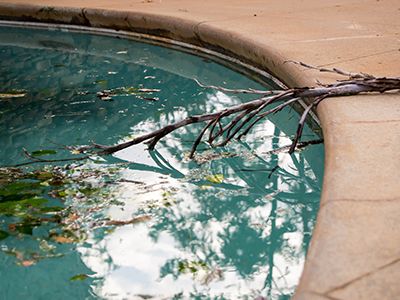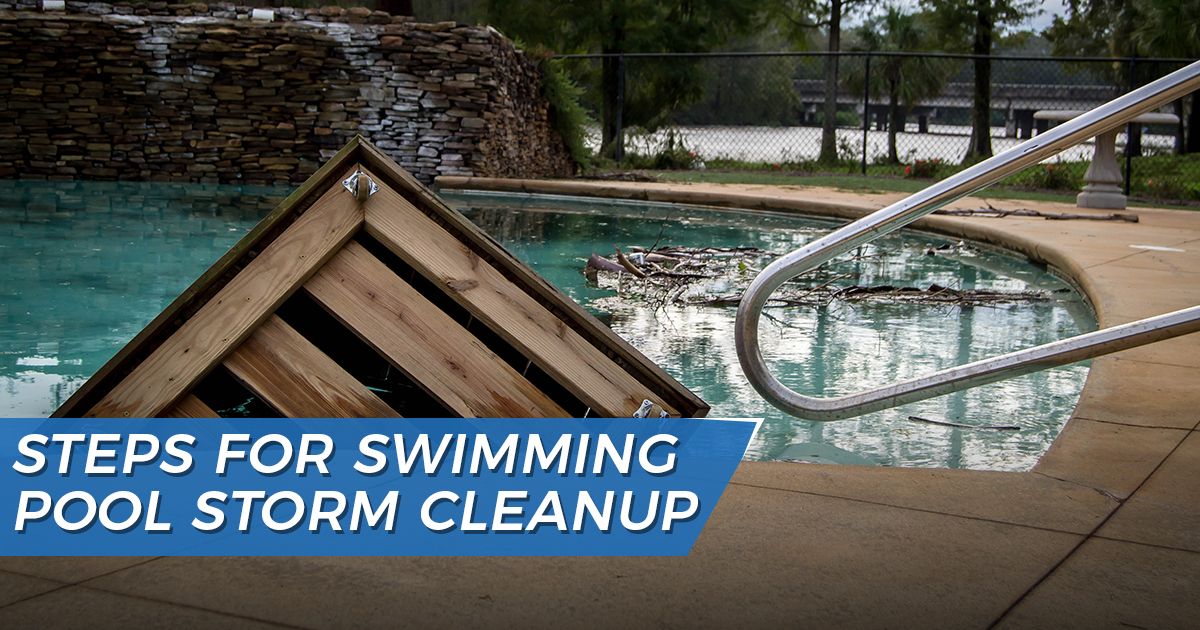Steps for Swimming Pool Storm Cleanup
Florida is known for severe tropical storms and even the occasional hurricane. High winds and heavy rain sweeps dirt and debris into your pool, raises the water level, changes the water chemistry, and may even cause damages that require repairs by a certified pool technician. Swimming pool storm cleanup can be a huge chore, but it’s vital that you immediately clean your swimming pool after a storm to prevent damage to your pool liner, concrete, and equipment. The longer you wait, the worse it can get, so prevent potential problems by learning how to clean a pool after a storm with these helpful tips. (Be sure to check our blog on How to Prepare Your Pool for a Storm or Hurricane!)
Swimming Pool Storm Cleanup Potential Issues
 While light rain generally has little effect on your pool water, algae spores and airborne debris could hitch a ride on each raindrop that falls into your pool during a storm. The result is a reaction from your chlorine as it attempts to fight off these invaders. The battle causes your active chlorine to drop and organic matter to decompose, which allows algae to reproduce and turn your water into a green mess.
While light rain generally has little effect on your pool water, algae spores and airborne debris could hitch a ride on each raindrop that falls into your pool during a storm. The result is a reaction from your chlorine as it attempts to fight off these invaders. The battle causes your active chlorine to drop and organic matter to decompose, which allows algae to reproduce and turn your water into a green mess.
When Mother Nature releases her fury with heavy rainfall that dilutes your pool’s chlorine level and turbulent winds that sweep larger pieces of debris into your pool, you’re faced with even more serious issues. Large pieces of debris can damage your swimming pool liner or shell, and potentially damage equipment. Combined with an increased water level that quickly becomes imbalanced, and your liner, concrete, and equipment are at risk of being damaged. You can help prevent some post-storm issues by properly preparing your swimming pool before the storm hits, and once it passes, begin swimming pool storm cleanup immediately.
Cleaning Your Swimming Pool After a Storm
When a storm leaves your pool a total mess, you might be tempted to drain it, but this could make matters much worse. When you drain a pool, especially when the ground surrounding it is saturated with water, the shell could shift or even pop up out of the ground. Instead of draining, follow these steps to get your pool cleaned up and running again.
Step 1: Remove Post Storm Debris
Swimming pool storm cleanup begins with removing as much debris from your pool as possible. Put on a pair of waterproof gloves before removing debris to protect your hands from any bacteria that might be present. Remove branches and other large pieces of debris by hand, then use a leaf net or skimmer to snag leaves, twigs, and other smaller debris. Clean debris from your skimmer and pump baskets to avoid clogging suction lines and equipment when you start your pump back up.
Step 2: Turn Pool Power Back On
Before the storm, you should have turned off and unplugged your pump. Leaving your pump running during a storm can cause electrical damage to the motor or cause it to completely short out. Never turn your pool equipment back on after a storm without first checking the electrical systems and components. You should contact your pool technician to check these components for you.
Step 3: Check Pool Water Levels
Heavy rain increases the water level in your pool, so you should lower this level by about two feet prior to a severe storm. This should help prevent overflowing pool water from entering your home, but you may still have to remove excess water. If you have little to no debris, you may be able to pump out excess water with your pump after hooking up your backwash hose and turning your filter to waste. However, it’s usually safer for your equipment to use a siphon or sump pump to remove excess water and keep debris out of your system.
Step 4: Clean andor Backwash Filter
It’s important to clean your pool filter before using it. A sand filter may only require backwashing, but it might also need chemical cleaning or a complete change of filter material. A D.E. filter also requires backwashing, plus you must open the tank, remove the manifold, take out all the grids, and rinse the tank and other components. If you have cartridge filters, replace any that are cracked or crushed, and simply use a garden hose and filter cleaner on them to get them clean.
Step 5: Brush and Vacuum
To rid the bottom of your pool of dirt and debris, grab your manual vacuum, or an automatic cleaner is even better. Run your vacuum directly to waste, if your pool setup allows it, instead of running the debris-filled water through your filter to save it from clogging. If you can’t vacuum to waste, keep an eye on your pressure gauge and backwash your filter regularly. Brush your pool walls to remove dirt and grim, then vacuum again. Repeat the process of brushing and vacuuming as necessary to remove as much dirt, debris, and bacteria as possible. If necessary, you can also use a flocculant to make heavy solids sink to the pool floor to be vacuumed out.
Step 6: Shock Your Swimming Pool After a Storm
When the chlorine in your water drops below 1.5 ppm, your pool becomes susceptible to bacteria, algae, and other problems. Thus, the first chemical you want to add is lots of chlorine to fight off contaminates. Even if you shocked your pool prior to the storm, you’ll want to shock your pool again afterwards. Depending on how bad your water is, you may need to use more than the normal amount of pool shock to raise the chlorine level to about 10 ppm.
Step 7: Test and Balance Your Water
Test your water after about 24 hours. If the chlorine has subsided to around 3 ppm, it’s time to get your water back in balance. Use an at-home kit to test water each time you make an adjustment. Start balancing your water chemistry by adjusting your total alkalinity first, which should be between 80 and 120 ppm. Next, adjust your pH to a range between 7.4 and 7.6. After a major storm, especially a hurricane, you may also need to adjust the calcium hardness and cyanuric acid. Wat 24 hours, then test again and make any necessary adjustments.
Ask Pool Professional How to Clean a Pool After a Storm
Contact the pool professionals at GPS Pool Store for expert advice on swimming pool storm cleanup. We can guide you through the process and make recommendations based on your specific type of pool. While most homeowners can handle typical cleanup steps, most don’t have the right knowledge or experience required to handle plumbing, electrical, and pool equipment issues.
If your pool suffers any type of damage, always turn to our knowledgeable pool technicians for pool surface and equipment repairs. With over two decades of experience providing premier swimming pool repairs, the GPS Pool Store staff confidently tackles all your post-storm issues. Call our locations in New Tampa, Lutz, or Land O’ Lakes to schedule your service today.

